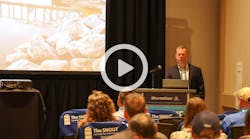
A recent study published in the Journal of Environmental Quality shows how the color of sediment can reveal its source.
Researchers from the University of Manitoba and the University of Northern British Columbia were able to identify the origins of sediments in Manitoba’s Tobacco Creek watershed, whose streams flow to the Red River and eventually to Lake Winnipeg. The process has been compared to a fingerprinting technique. “It’s not as particular as fingerprinting in a crime scene investigation,” says soil scientist David Lobb, “but we have the tools to get a sophisticated identification of the sources of sediments.”
A recent study published in the Journal of Environmental Quality shows how the color of sediment can reveal its source. Researchers from the University of Manitoba and the University of Northern British Columbia were able to identify the origins of sediments in Manitoba’s Tobacco Creek watershed, whose streams flow to the Red River and eventually to Lake Winnipeg. The process has been compared to a fingerprinting technique. “It’s not as particular as fingerprinting in a crime scene investigation,” says soil scientist David Lobb, “but we have the tools to get a sophisticated identification of the sources of sediments.” [text_ad] Suspended sediment samples were first collected at various points in the Tobacco Creek watershed. The reflectance spectra of the samples and of source materials were quantified using diffuse reflectance spectrometry, and then 16 color coefficients were derived. In very simple terms, Lobb says, darker sediments come from sources on the surface and lighter sediments from below the surface of the streams. Subsurface sediment is caused by erosion on the bottoms and sides of streams, while surface sediment—topsoil—comes from agricultural fields and riparian and forested areas. The results are not what you might expect. Most of the sediment in South Tobacco Creek comes from subsurface sources—from the streambanks themselves and from the rock escarpment the creek cuts its way through—rather than from manmade ones. Some of that is the result of natural stream erosion, but some is likely the result of the way human activity, such as farming and development, has changed the hydrology of the watershed overall. The fingerprinting process is inexpensive and fast, so it can most likely be replicated easily in other watersheds. “What to do with these answers is not as simple,” says Lobb. He adds, “The public is demanding actions and impacts on a watershed scale. Therefore, practices and processes have to reflect that larger regional scale.” Understanding the Hydrology of Your Own Watershed If you’re looking to understand more about how human activity and changes in land use affect the hydrology of the watershed, tune in to the September 10 webinar from Forester University, “Hydromodification 101: Predicting and Mitigating Stormwater Impacts to Stream Stability.” Presenter Judd Goodman, P.E., senior water resources engineer with Geosyntec Consultants, will discuss how hydromodification affects channel erosion, sedimentation, and other factors; how to model the potential impacts; and how to mitigate the damage. Click here for details and registration.Suspended sediment samples were first collected at various points in the Tobacco Creek watershed. The reflectance spectra of the samples and of source materials were quantified using diffuse reflectance spectrometry, and then 16 color coefficients were derived. In very simple terms, Lobb says, darker sediments come from sources on the surface and lighter sediments from below the surface of the streams. Subsurface sediment is caused by erosion on the bottoms and sides of streams, while surface sediment—topsoil—comes from agricultural fields and riparian and forested areas.
The results are not what you might expect. Most of the sediment in South Tobacco Creek comes from subsurface sources—from the streambanks themselves and from the rock escarpment the creek cuts its way through—rather than from manmade ones. Some of that is the result of natural stream erosion, but some is likely the result of the way human activity, such as farming and development, has changed the hydrology of the watershed overall.
The fingerprinting process is inexpensive and fast, so it can most likely be replicated easily in other watersheds. “What to do with these answers is not as simple,” says Lobb. He adds, “The public is demanding actions and impacts on a watershed scale. Therefore, practices and processes have to reflect that larger regional scale.”
Understanding the Hydrology of Your Own Watershed
If you’re looking to understand more about how human activity and changes in land use affect the hydrology of the watershed, tune in to the September 10 webinar from Forester University, “Hydromodification 101:
Predicting and Mitigating
Stormwater Impacts to Stream Stability.” Presenter Judd Goodman, P.E., senior water resources engineer with Geosyntec Consultants, will discuss how hydromodification affects channel erosion, sedimentation, and other factors; how to model the potential impacts; and how to mitigate the damage.
About the Author
Janice Kaspersen
Janice Kaspersen is the former editor of Erosion Control and Stormwater magazines.


